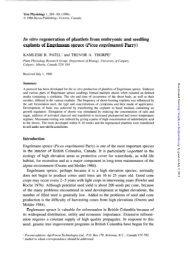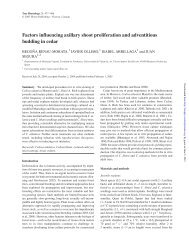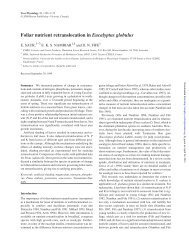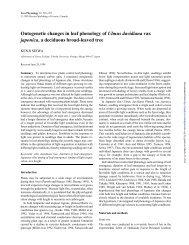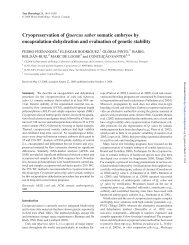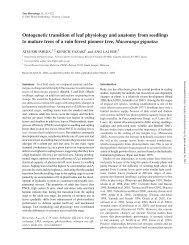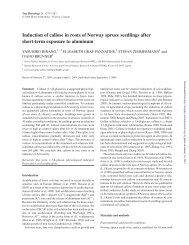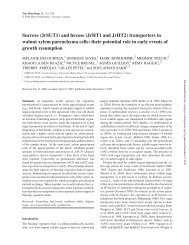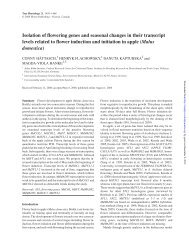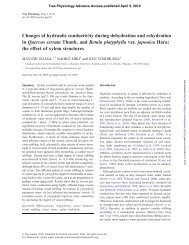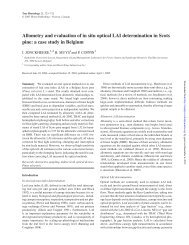Seasonal photosynthetic gas exchange and leaf ... - Tree Physiology
Seasonal photosynthetic gas exchange and leaf ... - Tree Physiology
Seasonal photosynthetic gas exchange and leaf ... - Tree Physiology
You also want an ePaper? Increase the reach of your titles
YUMPU automatically turns print PDFs into web optimized ePapers that Google loves.
1040 LETTS, PHELAN, JOHNSON AND ROOD<br />
measurements (Fv/Fm <strong>and</strong> ΦPSII) were made on the same<br />
leaves sampled for <strong>leaf</strong> reflectance, with an FMS2 pulse modulated<br />
chlorophyll fluorimeter (Hansatech Instruments, U.K.).<br />
Before Fv/Fm was determined, all leaves were dark adapted for<br />
a minimum of 30 min, using the <strong>leaf</strong> clip. About 30 s after<br />
measuring Fv/Fm, ΦPSII was determined on the same <strong>leaf</strong> tissue<br />
in full natural sunlight, rather than with the actinic light<br />
source.<br />
Stable carbon isotope composition<br />
A selection of dried leaves gathered on DOY 172, 205 <strong>and</strong> 237<br />
were chosen for N <strong>and</strong> δ 13 C analyses. Individual <strong>leaf</strong> samples<br />
were immersed in liquid nitrogen <strong>and</strong> crushed with a mortar<br />
<strong>and</strong> pestle. To determine stable carbon isotope composition<br />
<strong>and</strong> total N concentration (%), tissue samples (about 5 mg)<br />
were weighed into tin cups, <strong>and</strong> combusted in an elemental analyzer<br />
(NC2100, CE Instruments, ThermoQuest Italia, Milan,<br />
Italy), coupled to a <strong>gas</strong> isotope ratio mass spectrometer (Optima,VG<br />
Isotech, Cheshire, U.K.) operating in continuous<br />
flow mode. The δ 13 C was determined from the ratio, R<br />
( 13 CO2/ 12 CO2):<br />
δ 13<br />
C(‰) = ⎛ R<br />
⎜<br />
⎝ R<br />
sample<br />
std<br />
⎞<br />
⎟ 1000<br />
⎠<br />
where Rstd refers to the molar ratio of the international Pee Dee<br />
Belemnite st<strong>and</strong>ard.<br />
Photosynthetic water-use efficiency<br />
Photosynthetic water-use efficiency was calculated from both<br />
<strong>gas</strong> <strong>exchange</strong> measurements <strong>and</strong> from the δ 13 C composition of<br />
plant tissue. The former is an instantaneous measure of WUE,<br />
<strong>and</strong> was determined as:<br />
⎛ ci<br />
⎞<br />
ca<br />
⎜1<br />
− ⎟<br />
A ⎝ ca<br />
⎠<br />
WUE = =<br />
E 16 . v<br />
where 1.6 is the ratio of the diffusion coefficients of H2O <strong>and</strong><br />
CO2 <strong>and</strong> v is related to the difference between intracellular <strong>and</strong><br />
atmospheric H2O vapor concentrations (ei – ea; kPa) <strong>and</strong> atmospheric<br />
pressure, P (kPa) as:<br />
e − e<br />
v =<br />
P<br />
i a<br />
The stable carbon isotope composition of <strong>leaf</strong> tissue, δ 13 Cp,<br />
can be used to determine an integrated measure of WUE. The<br />
stable carbon isotope composition of <strong>leaf</strong> material is related to<br />
that of the source atmospheric CO2 (δ 13 Ca) <strong>and</strong> to ci/ca<br />
(Farquhar et al. 1982, 1989):<br />
(6)<br />
(7)<br />
(8)<br />
13 13<br />
δ C δ C a b a ci<br />
p = a − −( − ) (9)<br />
c<br />
a<br />
where δ 13 Ca is assumed to be –8‰, a is the discrimination during<br />
diffusion of CO2 in air (4.4‰), b is net discrimination during<br />
carboxylation (27.0‰) <strong>and</strong> ca is 380 µmol mol –1 , the mean<br />
CO2 concentration in July 2006 at Mauna Loa, Hawaii (Tans<br />
2007). We derived WUE from Equations 7 <strong>and</strong> 9 as (Ponton et<br />
al. 2006):<br />
13 13 ⎛ δ Cp − δ Ca + a⎞<br />
ca − ca⎜<br />
⎟<br />
A ⎝ a − b ⎠<br />
WUE = =<br />
E<br />
16 . v<br />
(10)<br />
Irrigation treatment<br />
To examine the effect of soil water availability on <strong>photosynthetic</strong><br />
<strong>gas</strong> <strong>exchange</strong> characteristics of male <strong>and</strong> female cottonwoods,<br />
45,000 l of water was pumped from the Oldman<br />
River to the base of two female <strong>and</strong> two male trees on DOY<br />
241. When irrigation was complete, the four trees were surrounded<br />
by st<strong>and</strong>ing water extending at least 4 m from the base<br />
of the trunk. On DOY 247, <strong>photosynthetic</strong> <strong>gas</strong> <strong>exchange</strong> <strong>and</strong><br />
<strong>leaf</strong> reflectance measurements were taken on three leaves of<br />
each of the four irrigated <strong>and</strong> four non-irrigated trees.<br />
Statistical analysis of physiological data<br />
Between-sex differences in <strong>leaf</strong> <strong>photosynthetic</strong> <strong>gas</strong> <strong>exchange</strong>,<br />
reflectance <strong>and</strong> fluorescence characteristics were assessed by<br />
mixed model repeated measures analysis of variance<br />
(ANOVA), with DOY as the repeated measure, sex as a fixed<br />
effect, tree identity as a r<strong>and</strong>om effect, sex × DOY interaction<br />
<strong>and</strong> post hoc evaluation by Tukey’s HSD test. Repeated measures<br />
ANOVA was also used to assess seasonal differences in<br />
<strong>photosynthetic</strong> <strong>gas</strong> <strong>exchange</strong>, foliar δ 13 C composition <strong>and</strong> Ψl<br />
(Phelan 2007). One-tailed Student’s t-tests were used to test<br />
two hypotheses: (1) females have significantly more conservative<br />
water use indicators than males, based on stable carbon<br />
isotope composition (higher δ 13 C <strong>and</strong> WUE, but lower ci/ca);<br />
<strong>and</strong> (2) irrigated trees have higher <strong>gas</strong> <strong>exchange</strong> rates <strong>and</strong><br />
lower WUE (Amax/E <strong>and</strong> Amax/gs) than non-irrigated trees.<br />
Results<br />
Environmental conditions<br />
TREE PHYSIOLOGY VOLUME 28, 2008<br />
Total precipitation at PCCG was 178.8 mm during DOY 121–<br />
247 (Table 1), with 76% occurring between DOY 146 <strong>and</strong> 171,<br />
<strong>and</strong> 48% occurring in a single event on DOY 165–166. Thereafter,<br />
rainfall was light, with all daily rainfall totals below<br />
8 mm. In response to this rainfall pattern <strong>and</strong> variation in water<br />
table depth, θv at 0.8-m depth was high in late June <strong>and</strong> early<br />
July, but decreased continuously from a peak of 0.40 m 3 m –3<br />
on DOY 170 through the months of July <strong>and</strong> August. Groundwater<br />
depth fell from –0.73 to –2.34 m from DOY 170 to 247.<br />
Total rainfall at PCCG was 23.5% below the 30-year mean for<br />
Fort Macleod during the study period (Table 1; Environment<br />
Canada 2005).<br />
Daily maximum air temperature <strong>and</strong> vapor pressure deficit<br />
were higher in July, August <strong>and</strong> early September than in May<br />
Downloaded from<br />
http://treephys.oxfordjournals.org/ by guest on February 4, 2013



